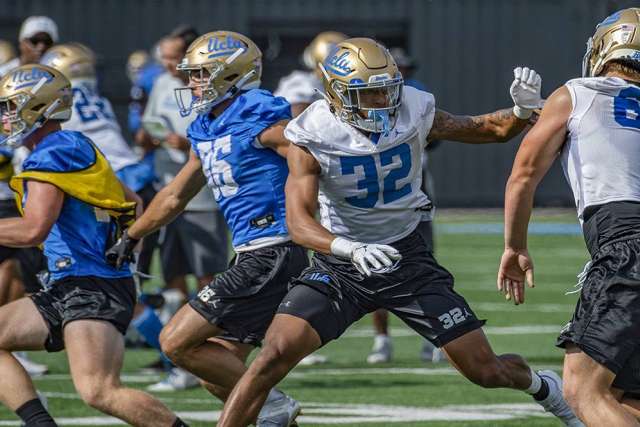About 300,000 football-related concussions occur annually in the U.S.
A wide receiver darts across the football field, his eyes locked on the ball thrown his way.
As the football travels toward him, he extends his hands to make the catch. Just as he secures the ball – BAM! He is blindsided in the head by a 6-foot-2, 250-pound linebacker.
He drops to the grass like a ragdoll with no life. The helmet-to-helmet contact causes him to drift in and out of consciousness for the next few seconds as he lays on the field.
He tries to stand up, but his balance is off. Medical personnel rush to help.
This is a weekly scene throughout the nation during football season.
Approximately 300,000 concussions occur annually in the United States from the sport of football alone. That, however, will not stop the thousands of gridiron athletes – from youth leagues, middle school, high school, college and the pros – from strapping up their shoulder pads and helmets.
Conversations revolving around chronic traumatic encephalopathy (CTE) – a brain degeneration linked to repeated head injuries – and traumatic brain injuries (TBI), will increase now that football season is upon us.
What is a concussion and how does it relate to CTE and TBI?
A concussion is a type of TBI that results from a hard blow or repetitive blows to the head. During a concussion, brain tissue can become swollen and result in dizziness and painful headaches or migraines.
What makes concussions particularly dangerous is that many athletes are unfamiliar with – or ignore – the symptoms and try to play through them. When this happens, it opens the door for other brain injuries and complications to occur. Too many concussions have been associated with the development of CTE.
What exactly is CTE and how do I know if I have it?
CTE is a degenerative brain disease that has been diagnosed in some athletes with a history of repeated concussions or blows to the head. The disease is most commonly linked to football players who played the high-velocity sport at the professional level for an extended period.
CTE can only be diagnosed in deceased patients by the study of their brain tissue. Some football players have authorized their brains to be studied in an autopsy.
But it’s not just football where athletes are often concussed. Other sports render a large number of concussions as well. According to the Centers for Disease Control and Prevention, there are an estimated 1.7 million to 3.6 million sports-related concussions yearly.
That’s why Dr. Christopher Giza, MD, director of the UCLA Steve Tisch BrainSPORT program, and his team are meticulously researching methods to reduce the number of brain injuries.
"What we do at BrainSPORT is we cover the whole range of sports and brain health," Dr. Giza explained. "Everybody focuses on concussions, but we focus on how exercise improves brain performance, how it improves attention and how it improves, what we call, plasticity in the brain. So whenever we talk about sports, there is actually a plus and minus. It is not all just risk of injury. There are a lot of bonuses."

There’s an acronym in the BrainSPORT name that Dr. Giza and his team adhere to as they work to improve brain health:
S-Safety
P-Performance
O-Outreach
R-Research
T-Treatment
Each element is critical to the program's mission, which is to transfer knowledge of sports-related concussions and brain health to the broader community.
What is the difference between a mild traumatic brain injury and a severe traumatic brain injury?
Concussions are often associated with mild traumatic brain injuries. They are caused by a blow to the head that causes the head and brain to jolt forward or backward quickly. The blow can often cause brain cells to become damaged or create chemical changes to the brain. Mild traumatic brain injuries usually are not associated with periods of unconsciousness.
Severe traumatic brain injuries are caused by high-impact blows that directly affect the brain and its function. STBI's are almost always associated with a period of unconsciousness.
How is BrainSPORT working to decrease concussions and other TBI-related injuries?
Outreach, research and treatment are the most significant components of the BrainSPORT program, Dr. Giza said.
"We go out to high schools, and we did a big thing with the Dodgers Foundation and youth baseball coaches, where we educated hundreds of athletes and coaches on sports safety,” he said.
Dr. Giza said research and treatment are vital because they serve a range of patients with different neurological needs.
Should I be concerned if my child or family member participates in a contact sport?
At the high school level, football accounts for roughly 60% of the concussions that happen to athletes yearly, according to the . The other sports that account for concussions are lacrosse, soccer, basketball and baseball, if players are struck in the head by a pitch.
Dr. Giza advises parents to talk to their children about the dangers of playing contact sports and the potential effect on their future health. Repetitive blows to the head can cause chronic head trauma and may lead to brain diseases such as CTE.
Dr. Giza said athletes should make a point of recognizing symptoms of a possible brain injury or concussion:
Concussion/TBI symptoms:
- Dizziness
- Headaches
- Blurred vision
- Nausea/vomiting
- Sensitivity to light or noise
- Unsteadiness/lack of coordination
- Disorientation
- Trouble speaking or articulating
- Fatigue
If athletes are experiencing any of these during competition, they should stop playing immediately to avoid further brain injury, including the possibility of CTE.
How much does new technology for helmets and other protective gear help to limit or prevent brain injuries?
Though the NFL, NCAA and high school sports associations have gone to great lengths to improve protective wear, there is not much an enhanced helmet can do against TBI.
Over the past few years, doctors and other medical providers have partnered with scientists and engineers to design helmets with more flexibility and layered protection. The purpose is for the helmet to absorb more of the shock and reduce force during impact.
"It helps when technology gets better. Anything to reduce impact can be beneficial, but we don't want to rely overly on technology," Dr. Giza warns. “While a good helmet can definitely protect against skull fractures and brain bleeds, there is less it can do to completely prevent concussions.”
Dr. Giza said "brain movement" is the primary cause of brain injury in a collision sport.
"Your brain is floating inside your skull like a pickle in a pickle jar. If you shake the jar the pickle is going to move around. Even if I put a helmet on that jar, the pickle is still going to move around. So, there is no helmet that can stop your brain from moving around," Dr. Giza explained.
Protecting athletes in contact sports
The NFL and NCAA have set a precedent for high school football teams and Pop Warner football youth leagues to follow.
Once upon a time, football allowed defensive players to lower their heads when they made a tackle and helmet-to-helmet contact was allowed. Now, defenders are required to tackle with their head up, and head-to-head contact results in stiff penalties. At the collegiate level, players are ejected for initiating head-to-head contact, whether it's incidental or not.
The new era is focused on protecting the athletes, particularly in football. However, athletes who enter sports such as MMA (Mixed Martial Arts) fighting or boxing do not have such luxuries. Both sports are helmetless competitions. Athletes in those sports suffer blows to the head in every match, making TBI virtually unavoidable at some point in their life.
Dr. Giza advises athletes who endure blows to the head to seek medical assistance immediately and shed the "tough guy" act.
"The mentality often in sports is, 'I'm just going to rub some dirt on it and get back in there. I'm going to be tough,'” he said. “That creates a situation where that individual will be setting themselves up for repetitive injuries and now becomes a risk for long-term problems."
In many instances, saving athletes from themselves is among the best ways to protect them.
"It's not all on the athlete," Dr. Giza continued. "An athlete that is disoriented is not the best person to recognize the symptoms as a part of the concussion."
What can athletes who participate in contact sports do to optimize their cognitive health?
Exercise is a common strategy an athlete can use to boost neurological functions.
"So we know a number of methods can maintain your cognitive health through your whole lifetime and they're not unique to people who hit their head. They're good for preventing cognitive problems that may ultimately turn into Alzheimer's. They're good for preventing what we call vascular dementia. One of these methods is aerobic exercise," Dr. Giza said.
Dr. Giza cites research that shows aerobic exercise increases growth factors and blood flow in the brain.
"So there's a biological benefit. It's a type of medicine that doesn't require taking a pill. It does some natural things to brain and body. It causes your brain to make natural painkillers," said Dr. Giza.
"So if you ever heard people use the term 'runner's high,' that is a real thing,” he continued.
“There are peptides in the brain called endorphins that allow people doing aerobic exercises to have natural painkillers. So when we see patients who have concussions or chronic headaches, and they're not responding well to medications, sometimes that's because we have to add in some exercise."
Recent studies have even shown that prescribed aerobic exercise may speed recovery from a concussion in youth athletes. by Leddy et al., JAMA Pediatrics, 2019.
If you have questions about sport or non-sport-related injuries, or if you want to book an appointment, visit .




